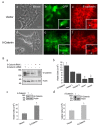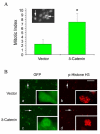delta-Catenin promotes prostate cancer cell growth and progression by altering cell cycle and survival gene profiles
- PMID: 19284555
- PMCID: PMC2660279
- DOI: 10.1186/1476-4598-8-19
delta-Catenin promotes prostate cancer cell growth and progression by altering cell cycle and survival gene profiles
Abstract
Background: delta-Catenin is a unique member of beta-catenin/armadillo domain superfamily proteins and its primary expression is restricted to the brain. However, delta-catenin is upregulated in human prostatic adenocarcinomas, although the effects of delta-catenin overexpression in prostate cancer are unclear. We hypothesized that delta-catenin plays a direct role in prostate cancer progression by altering gene profiles of cell cycle regulation and cell survival.
Results: We employed gene transfection and small interfering RNA to demonstrate that increased delta-catenin expression promoted, whereas its knockdown suppressed prostate cancer cell viability. delta-Catenin promoted prostate cancer cell colony formation in soft agar as well as tumor xenograft growth in nude mice. Deletion of either the amino-terminal or carboxyl-terminal sequences outside the armadillo domains abolished the tumor promoting effects of delta-catenin. Quantitative RT2 Profiler PCR Arrays demonstrated gene alterations involved in cell cycle and survival regulation. delta-Catenin overexpression upregulated cyclin D1 and cdc34, increased phosphorylated histone-H3, and promoted the entry of mitosis. In addition, delta-catenin overexpression resulted in increased expression of cell survival genes Bcl-2 and survivin while reducing the cell cycle inhibitor p21Cip1.
Conclusion: Taken together, our studies suggest that at least one consequence of an increased expression of delta-catenin in human prostate cancer is the alteration of cell cycle and survival gene profiles, thereby promoting tumor progression.
Figures





References
-
- Ho C, Zhou J, Medina M, Goto T, Jacobson M, Bhide PG, Kosik KS. delta-catenin is a nervous system-specific adherens junction protein which undergoes dynamic relocalization during development. J Comp Neurol. 2000;420:261–276. doi: 10.1002/(SICI)1096-9861(20000501)420:2<261::AID-CNE8>3.0.CO;2-Q. - DOI - PubMed
Publication types
MeSH terms
Substances
Grants and funding
LinkOut - more resources
Full Text Sources
Other Literature Sources
Medical
Research Materials

